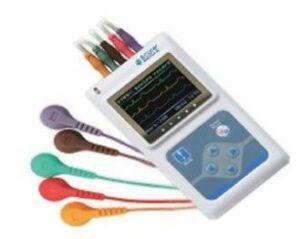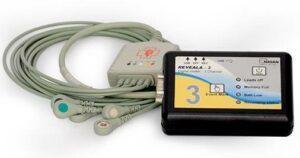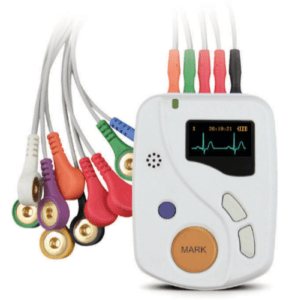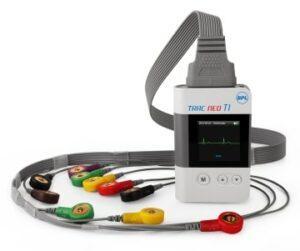Are you ready to take control of your heart health? In this blog, we dive into the world of Holter ECG monitor, revolutionizing the way we monitor and assess cardiovascular well-being. From understanding the features and benefits of portable ECG monitors to exploring the advantages of ambulatory and wireless technology, we uncover the key insights that enable individuals to track their heart health anytime, anywhere.
At Medzell, our mission is to promote cutting-edge medical devices, including Holter ECG monitors, through our futuristic B2B platform. Join us as we delve into the intricacies of ECG monitoring, demystify heart rhythm analysis, and reveal the capabilities of cardiac event monitors. Together, let’s optimize our heart health management and unlock a lifetime of vitality.
Understanding Holter ECG Monitors
Holter ECG monitors are essential tools in cardiac monitoring that provide valuable insights into the heart’s electrical activity over an extended period. Let’s explore the different aspects and types of Holter ECG monitors to gain a comprehensive understanding
- Holter ECG Monitoring: Holter ECG monitoring involves the continuous recording of the heart’s electrical signals using a portable device. This non-invasive procedure helps detect irregular heart rhythms, assess treatment effectiveness, and aid in the diagnosis of various heart conditions.
- Standard Holter Monitors: Standard Holter monitors are the most common type of ECG monitors used in clinical settings. These monitors consist of a small recorder that is connected to electrodes placed on the chest. Patients wear the monitor for 24 to 48 hours, during which it records their heart’s electrical activity.
- Extended-Wear Holter Monitors: Extended-wear Holter monitors offer longer monitoring durations, typically ranging from three to seven days. These monitors offer a more thorough evaluation of the heart’s activity and are helpful for patients who experience sporadic symptoms or who may have cardiac abnormalities that do not always manifest within a 24-hour window.
- Event Monitors: Event monitors are designed to record specific cardiac events or symptoms experienced by the patient. These monitors are activated by the user when they feel symptoms such as palpitations or irregular heart rhythms. Event monitors are especially useful for capturing infrequent or sporadic episodes.
- Wireless Holter Monitors: Wireless Holter monitors leverage wireless technology to transmit ECG data to a separate recording device or a smartphone app. These monitors eliminate the need for physical wires and cables, providing increased comfort and freedom of movement for the wearer.
- Patch-Based Monitors: Patch-based Holter monitors are adhesive patches that adhere to the chest and continuously record the heart’s electrical activity. These monitors are lightweight, discreet, and offer a comfortable monitoring experience. They are particularly suitable for patients who prefer a non-intrusive option.
- Smartphone-Compatible Monitors: Some Holter ECG monitors can be connected to smartphones or tablets via dedicated apps. These monitors enable real-time data visualization, comprehensive analysis, and convenient data storage, empowering users to actively participate in monitoring their heart health.
Understanding the different types of Holter ECG monitors allows individuals to make informed decisions about their cardiac health. It’s crucial to consult with healthcare professionals to determine the most suitable monitoring approach based on specific needs and medical requirements.
Uncover the Convenience and Portability of ECG Monitoring with Portable Devices
In recent years, especially when it comes to cardiovascular health, modern medical technology has fundamentally altered how we monitor our health. Portable ECG monitors have emerged as a game-changer in cardiac monitoring, offering unmatched convenience and portability. Let’s explore how these devices empower individuals to track their heart health anytime, anywhere.
- On-the-Go Monitoring: Portable ECG monitors provide the flexibility to monitor your heart’s electrical activity while on the move. Whether you’re traveling, at work, or engaging in daily activities, these devices allow you to stay proactive in managing your cardiovascular well-being without interrupting your routine.
- Compact and Lightweight: Portable ECG monitors are made to be small and light, which makes them convenient to wear and carry. Their ergonomic designs ensure maximum comfort, allowing users to wear them discreetly and without any inconvenience.
- User-Friendly Operation: The ease of usage of these gadgets was considered during design. They typically feature intuitive interfaces and simple operation, enabling individuals to initiate and stop ECG recordings effortlessly. This ease of use makes portable ECG monitors accessible to users of all ages and technological backgrounds.
- Continuous Monitoring: Portable ECG monitors offer continuous monitoring, allowing for a comprehensive assessment of your heart’s electrical activity over an extended period. This extended monitoring duration increases the likelihood of capturing irregular heart rhythms or potential cardiac issues that may not be evident during a short-term assessment.
- Data Storage and Analysis: These devices come equipped with built-in memory or external storage options to store ECG data. Many portable ECG monitors also integrate with smartphone apps or computer software, enabling users to conveniently transfer and analyze their recorded data for deeper insights and discussions with healthcare professionals.
- Empowerment and Awareness: Portable ECG monitors empower individuals to take charge of their heart health. By actively monitoring their heart’s electrical activity, individuals gain a deeper understanding of their cardiovascular well-being, identify potential irregularities, and seek appropriate medical attention when needed.
- Peace of Mind: With portable ECG monitors, individuals can experience peace of mind knowing they have a reliable and portable tool to monitor their heart health. These devices provide reassurance, especially for those with a history of heart conditions or individuals who want to be proactive in preventing potential cardiovascular issues.
The convenience and portability of portable ECG monitors have transformed cardiac monitoring, allowing individuals to stay connected to their heart’s health with ease. By incorporating these devices into your healthcare routine, you can actively monitor your cardiovascular well-being and take proactive steps towards a healthier heart.
Delve into the Advantages Offered by Ambulatory ECG Monitors
Ambulatory ECG monitors, often known as wearable ECG monitors, have fundamentally altered how cardiac monitoring is carried out by continually and covertly observing the electrical activity of the heart as a person goes about their daily activities. These devices offer several advantages that make them invaluable tools for detecting irregular heart rhythms, identifying potential issues, and aiding in accurate diagnoses. Let’s explore the benefits of ambulatory ECG monitors in more detail:
- Continuous Monitoring: Ambulatory ECG monitors allow long-term, often 24 to 48 hours or even longer, continuous monitoring of the electrical activity of the heart. This extended monitoring duration allows for the capture of irregular heart rhythms and potential cardiac issues that may not be detectable during shorter-term assessments.
- Real-time Data: These monitors provide real-time data on the heart’s electrical activity, allowing healthcare professionals to analyze and interpret the data promptly. This real-time feedback enables timely interventions and adjustments to treatment plans, leading to more accurate diagnoses and improved patient care.
- Unobtrusive Design: Ambulatory ECG monitors are designed to be worn comfortably throughout the day without interfering with daily activities. They are lightweight, compact, and discreet, allowing individuals to go about their routine while receiving continuous cardiac monitoring.
- Mobility and Flexibility: With ambulatory ECG monitors, individuals have the freedom to move and engage in various activities while their heart’s electrical activity is being recorded. This mobility and flexibility enable a more accurate assessment of the heart’s function during real-life situations, ensuring a comprehensive evaluation.
- Event Recording: Many ambulatory ECG monitors come with event recording capabilities. Individuals can manually trigger the recording when they experience symptoms such as palpitations or irregular heart rhythms. This feature allows for the capture of specific events and aids in diagnosing elusive cardiac conditions.
- Enhanced Diagnosis: Ambulatory ECG monitors provide healthcare professionals with a wealth of data for accurate diagnosis. The continuous monitoring and comprehensive data collected over an extended period enable the detection of subtle abnormalities, identification of potential arrhythmias, and assessment of treatment effectiveness.
- Tailored Treatment Plans: The data collected by ambulatory ECG monitors helps healthcare professionals tailor personalized treatment plans. By gaining insights into the heart’s electrical activity during daily activities, healthcare providers can make informed decisions regarding medication adjustments, lifestyle modifications, or further diagnostic tests.
Ambulatory ECG monitors offer numerous advantages in terms of continuous monitoring, real-time data, unobtrusive design, mobility, event recording, enhanced diagnosis, and tailored treatment plans. These devices empower individuals to take a proactive approach to their heart health and assist healthcare professionals in providing accurate diagnoses and optimal care. By utilizing ambulatory ECG monitors, individuals can actively monitor their cardiovascular well-being and contribute to long-term heart health management.
Explore the Wireless Revolution in ECG Monitoring
The field of ECG monitoring has witnessed a revolutionary transformation with the advent of wireless ECG monitors. These innovative devices have eliminated the hassle of wires and cables traditionally associated with ECG monitoring, providing a seamless and comfortable experience for both patients and healthcare professionals. Let’s delve into the convenience, freedom, and advancements offered by wireless ECG monitors and embrace a new era of cardiac monitoring technology
- Wire-Free Monitoring: Wireless ECG monitors, as the name suggests, do not require cumbersome wires or cables to transmit data. Instead, they connect to a compatible device, such a smartphone or specialised receiver, using wireless technologies like Bluetooth or Wi-Fi. This wire-free monitoring eliminates the discomfort and restrictions associated with traditional wired setups, offering individuals a more convenient and hassle-free experience.
- Seamless Connectivity: Wireless ECG monitors seamlessly connect with smartphones, tablets, or other devices, enabling easy access to real-time data and analysis. The captured ECG signals are transmitted wirelessly to the connected device, where specialized applications or software process and display the information. This connectivity empowers individuals to monitor their heart health anytime, anywhere, without the need for dedicated equipment or frequent visits to healthcare facilities.
- Convenience and Portability: The wireless nature of these monitors makes them highly portable and convenient to use. They are lightweight, compact, and designed to be carried or worn comfortably, allowing individuals to continue with their daily activities while their heart’s electrical activity is being monitored. This portability ensures continuous monitoring during real-life situations, providing a comprehensive assessment of cardiac health.
- Data Tracking and Analysis: Wireless ECG monitors often come with dedicated mobile applications or software platforms that facilitate data tracking and analysis. These user-friendly interfaces allow individuals to view and analyze their ECG recordings, track changes over time, and share the data with healthcare professionals for further evaluation. The ability to track and analyze data in real-time promotes proactive management of heart health and enables early detection of abnormalities.
- Remote Monitoring and Telemedicine: The wireless connectivity of these monitors opens up new possibilities for remote monitoring and telemedicine. Individuals can securely share their ECG data with healthcare professionals, regardless of geographical distance. This feature is particularly beneficial for individuals living in remote areas or those requiring frequent monitoring, as it reduces the need for in-person visits and allows for timely remote consultations and interventions.
- Integration with Health Platforms: Wireless ECG monitors often integrate with health platforms and wearable ecosystems, allowing individuals to consolidate their health data in a single interface. This integration enables a holistic view of one’s health metrics, including ECG data, heart rate, activity levels, and more. By leveraging the capabilities of these platforms, individuals can gain deeper insights into their overall well-being and make informed decisions regarding their cardiac health.
Demystifying ECG Monitoring
ECG monitoring plays a crucial role in assessing cardiac health and detecting potential abnormalities in the heart’s electrical activity. By understanding the intricacies of ECG monitoring, individuals can gain insights into their heart’s function and collaborate effectively with healthcare professionals for accurate diagnosis and treatment. Let’s explore the field of cardiac rhythm analysis using ECG data and explain how ECG monitoring works:
- Heart Rhythm Analysis: The electrocardiogram, or ECG, is a recording and analysis of the heart’s electrical signals (ECG). This evaluation aids in the detection of anomalies, irregularities, and probable heart problems. By examining the various components of the ECG waveform, such as P waves, QRS complexes, and T waves, healthcare professionals can evaluate the heart’s rhythm, rate, and overall electrical activity.
- Diagnostic Significance: For the diagnosis and treatment of numerous heart disorders, accurate heart rhythm analysis is crucial. ECG monitoring provides valuable insights into the presence of arrhythmias, which are abnormal heart rhythms. These irregularities could be signs of bradycardia, ventricular tachycardia, or atrial fibrillation. Detecting and analyzing these abnormalities helps healthcare professionals make informed decisions regarding further diagnostic tests, treatment options, and ongoing care plans.
- Holter Monitoring: One of the key methods of ECG monitoring is Holter monitoring. It involves wearing a portable device called a Holter monitor that continuously records the heart’s electrical activity over an extended period, typically 24 to 48 hours or even longer. Holter monitoring provides a comprehensive view of the heart’s function during daily activities and captures any irregularities or transient events that may not be captured in a short-term ECG test.
- Arrhythmia Detection: ECG monitoring is particularly effective in detecting arrhythmias. These abnormal heart rhythms can be intermittent or sporadic, making their diagnosis challenging. Holter monitors and other ambulatory ECG devices help capture and record these irregular heart rhythms, allowing healthcare professionals to analyze and identify the specific type and frequency of arrhythmias. This information guides the development of appropriate treatment strategies and helps monitor the effectiveness of interventions.
- Tailored Treatment Plans: Accurate heart rhythm analysis through ECG monitoring plays a vital role in tailoring personalized treatment plans. By identifying the specific type and severity of arrhythmias, healthcare professionals can prescribe targeted medications, recommend lifestyle modifications, or even consider invasive procedures like catheter ablation or pacemaker implantation. ECG monitoring data enables the evaluation of treatment effectiveness over time and facilitates adjustments for optimal outcomes.
- Collaboration with Healthcare Professionals: Understanding ECG monitoring empowers individuals to actively participate in their cardiac care. By familiarizing themselves with the basics of ECG interpretation, individuals can engage in meaningful discussions with healthcare professionals. They can ask questions, seek clarifications, and better comprehend their test results. This collaboration fosters a shared decision-making process, promotes patient education, and enhances overall cardiac health management.
Demystifying ECG monitoring allows individuals to grasp the significance of heart rhythm analysis and its role in diagnosing and treating cardiac conditions. By staying informed about their heart’s electrical activity, individuals can take proactive steps towards a healthier cardiovascular system. Embrace the power of ECG monitoring and unlock a deeper understanding of your heart’s health.
Dive into the World of Heart Rhythm Analysis through ECG Data
Heart rhythm analysis is a fundamental aspect of assessing cardiovascular health and diagnosing various cardiac conditions. People can better comprehend their heart’s electrical activity and the insights it offers by learning about heart rhythm analysis using electrocardiogram (ECG) data. Let’s explore this fascinating field and unravel the significance of ECG data analysis:
What is Heart Rhythm Analysis?: Heart rhythm analysis involves the interpretation of ECG data to evaluate the regularity, rate, and pattern of the heart’s electrical impulses. The ECG waveform, consisting of P-waves, QRS complexes, and T-waves, provides valuable information about the heart’s depolarization and repolarization phases. By analyzing these components, healthcare professionals can assess the heart’s rhythm, identify any abnormalities, and make informed decisions about diagnosis and treatment.
- Detecting Abnormalities: Heart rhythm analysis helps detect irregularities and abnormalities in the heart’s electrical activity. It enables health professionals to identify a variety of heart conditions, such as arrhythmias, atrial fibrillation, ventricular tachycardia, and bradycardia. By carefully examining the ECG waveform, they can spot deviations from the normal pattern, which may indicate underlying cardiac issues requiring further evaluation and intervention.
- Diagnostic Value: Accurate heart rhythm analysis is crucial for diagnosing and managing cardiac conditions. ECG data provides vital information about the duration, frequency, and severity of irregular heart rhythms. By analyzing the ECG waveform and correlating it with the individual’s symptoms, medical history, and other diagnostic tests, healthcare professionals can make precise diagnoses and develop tailored treatment plans. This analysis helps ensure timely interventions and promotes better outcomes for patients.
- Holter Monitoring: One of the primary methods for obtaining ECG data is through Holter monitoring. It involves wearing a portable device called a Holter monitor, which continuously records the heart’s electrical activity over an extended period, typically 24 to 48 hours or longer. Holter monitoring captures data during daily activities, providing a comprehensive view of the heart’s function and allowing for the detection of transient or intermittent arrhythmias that may not be apparent during a short-term ECG.
- Long-Term Monitoring Benefits: ECG data obtained through long-term monitoring offers several advantages. It enables healthcare professionals to evaluate the heart’s activity over an extended period, capturing fluctuations and trends in the electrical signals. For detecting infrequent arrhythmias, gauging the success of therapeutic measures, and tracking the development of heart diseases, long-term surveillance is particularly helpful. It provides a more comprehensive and accurate assessment of the heart’s health.
- Collaboration and Education: Understanding heart rhythm analysis through ECG data empowers individuals to actively participate in their cardiac care. By familiarizing themselves with the basics of ECG interpretation, individuals can engage in meaningful discussions with healthcare professionals. They can gain insights into their test results, ask questions, and contribute to shared decision-making processes. This collaboration facilitates better patient education, promotes adherence to treatment plans, and enhances overall cardiovascular health management.
Explore the Benefits and Applications of Holter Monitoring
Holter monitoring is a useful diagnostic tool that records an electrocardiogram (ECG) continuously for a long time, usually between 24 and 48 hours or more. This non-invasive method offers several benefits and finds applications in various cardiac scenarios. Let’s explore the advantages and applications of Holter monitoring:
- Comprehensive Cardiac Assessment: Holter monitoring captures a continuous stream of ECG data, providing a comprehensive assessment of the heart’s electrical activity over an extended period. With the use of this extensive recording, medical practitioners can identify and assess a number of cardiac problems, such as arrhythmias, atrial fibrillation, bradycardia, and tachycardia. By examining the ECG tracings, medical professionals can identify irregularities, assess the severity of symptoms, and make accurate diagnoses.
- Detecting Transient Events: Unlike traditional ECG tests performed in a clinical setting, Holter monitoring records the heart’s activity during everyday activities, including sleep, exercise, and routine tasks. This feature enables the detection of transient or intermittent cardiac events that may not occur during short-term ECG tests. Holter monitoring is particularly useful for capturing infrequent arrhythmias, assessing their frequency and duration, and identifying underlying patterns or triggers.
- Tailoring Treatment Plans: The continuous recording provided by Holter monitoring helps healthcare professionals evaluate the effectiveness of treatment interventions. By analyzing the ECG data, medical professionals can assess the impact of medications, lifestyle modifications, or other therapeutic measures on the heart’s electrical activity. This information guides the development of tailored treatment plans, allowing for adjustments and optimization based on individual patient responses.
- Assessing Treatment Efficacy: Assessing the effectiveness of anti-arrhythmic drugs and other therapies requires the use of holter monitoring. Healthcare providers can assess the effect of interventions on the frequency and severity of arrhythmias by comparing pre- and post-treatment ECG data. This information guides treatment decisions, helping healthcare providers determine whether to continue current therapies, adjust medication dosages, or explore alternative treatment options.
- Risk Stratification: Holter monitoring aids in risk stratification for cardiovascular events. The data obtained from Holter monitoring helps identify individuals at higher risk for adverse cardiac outcomes. By analyzing heart rate variability, ST-segment changes, and other ECG parameters, healthcare professionals can assess the individual’s risk profile and make informed decisions regarding further diagnostic testing, intervention, or monitoring.
- Research and Clinical Studies: Holter monitoring is a valuable tool in research and clinical studies related to cardiovascular health. Large-scale studies utilize Holter monitoring to collect data from a significant number of participants, contributing to a better understanding of cardiac conditions, risk factors, and treatment outcomes. The data obtained from Holter monitoring is valuable for studying the effectiveness of new therapies, evaluating the impact of lifestyle factors on cardiac health, and identifying novel biomarkers.
Holter monitoring provides a comprehensive and detailed assessment of the heart’s electrical activity over an extended period. Its applications range from diagnosing cardiac abnormalities to evaluating treatment efficacy and risk stratification. By utilizing Holter monitoring, healthcare professionals can make informed decisions, tailor treatment plans, and optimize patient care for better cardiovascular outcomes. Embrace the benefits of Holter monitoring and unlock new insights into your heart’s health.
Holter ECG Monitor From Leading Indian Manufacturers
Cordis 12
Cordis 12 is a Holter ECG Monitor manufactured by Recorders & Medicare Systems Pvt. Ltd. (RMS India), a leading manufacturer and global supplier of Holter ECG Monitors in India. Electrocardiography Holter monitors are ambulatory electrocardiography devices that are used to monitor cardiac activity. With 48 hours of continuous recording, Cordis 12 provides an extensive monitoring period for accurate data capture. Its durable and streamlined design ensures comfort for patients during monitoring, making it suitable for use at clinics, hospitals, home, and the workplace. The device features an event marking function for easy identification of specific events during monitoring. It also includes a removable SD card and USB for efficient data transfer, enabling healthcare professionals to conveniently analyze and interpret ECG data. Cordis 12 offers flexible atrial fibrillation analysis, powerful pacemaker analysis on modes such as AAI and VVI, T-wave alternation analysis, and heart rate turbulence (HRT) analysis. These advanced features make Cordis 12 an essential tool for healthcare professionals in diagnosing and managing cardiac conditions.
Trac Neo T1
Trac Neo T1 is a Holter ECG recorder manufactured by BPL Medical Technologies Private Limited. It features a waterproof design that provides protection against water and dust, ensuring durability and reliability in various environments. The recorder is equipped with a color display, allowing for visual confirmation of patient hook-up and ensuring accurate monitoring. Healthcare professionals can select the desired sampling rate and AD resolution, providing flexibility in recording parameters. The Trac Neo T1 offers real-time waveform display on its OLED screen, allowing for convenient monitoring of ECG data. Its compact and lightweight design enhances portability and ease of use. The device offers two optional modes of ECG data transfer: via a USB cable connected to a PC or using a microSD card reader. It also incorporates a unique multi-channel pacemaker detect circuit and IP27 level protection against water and dust. With 10 electrodes standard lead wires, it can create a 12-lead ECG signal. Trac Neo T1 is a reliable and efficient Holter ECG recorder, supporting healthcare professionals in accurate cardiac monitoring and diagnosis.
ECGH 300
 Introducing the ECGH 300: Portable Wireless ECG Holter Monitor for Accurate Heart Analysis. Manufactured by Silverline Meditech Pvt. Ltd. in India, this device offers continuous ECG monitoring for 24 hours, providing precise data for heart analysis. It features ECG Holter analysis software, a digital recorder, and Bluetooth connectivity for seamless data transfer. With GPS tracking, real-time alerts, and arrhythmia detection, it allows easy identification of irregular heart rhythms. The ECGH 300 ensures patient comfort and convenience, enabling daily activities while being monitored. Silverline Meditech Pvt. Ltd. offers interpretation services and professional training, promoting accurate device utilization. With telemedicine capabilities and user-friendly software, it is the ideal choice for efficient ECG Holter monitoring.
Introducing the ECGH 300: Portable Wireless ECG Holter Monitor for Accurate Heart Analysis. Manufactured by Silverline Meditech Pvt. Ltd. in India, this device offers continuous ECG monitoring for 24 hours, providing precise data for heart analysis. It features ECG Holter analysis software, a digital recorder, and Bluetooth connectivity for seamless data transfer. With GPS tracking, real-time alerts, and arrhythmia detection, it allows easy identification of irregular heart rhythms. The ECGH 300 ensures patient comfort and convenience, enabling daily activities while being monitored. Silverline Meditech Pvt. Ltd. offers interpretation services and professional training, promoting accurate device utilization. With telemedicine capabilities and user-friendly software, it is the ideal choice for efficient ECG Holter monitoring.
REVEALED 3
 REVEALA 3 is a three-channel solid-state digital Holter system manufactured by Nasan Medical Electronics Pvt. Ltd. It is designed to record, analyze, evaluate, and report electrocardiograms for arrhythmic disorder classification. REVEALA 3 offers various features to support cardiac analysis and reporting. It includes arrhythmia disclosure and summary, template summary, ST analysis report, summary report, and heart rate variability report. The device stores three channels of ECG data for 24 hours, providing a comprehensive recording period for accurate analysis. It offers the option to select normal beats automatically or manually, allowing flexibility in data analysis. The selected channel polarity can be reversed if necessary, enabling customization for specific needs. Healthcare professionals can view the ECG data of all channels and beats in selected templates, facilitating detailed analysis and evaluation. The device allows for editing the arrhythmia type of individual beats, ensuring accurate classification and analysis. It also provides the facility to view trends of heart rate, detected arrhythmias, and ST level across all channels, enabling comprehensive evaluation of cardiac parameters. REVEALA 3 by Nasan Medical Electronics Pvt. Ltd. is a comprehensive and reliable continuous ECG Holter monitoring system, providing advanced features and analysis capabilities to assist healthcare professionals in diagnosing and managing arrhythmic disorders.
REVEALA 3 is a three-channel solid-state digital Holter system manufactured by Nasan Medical Electronics Pvt. Ltd. It is designed to record, analyze, evaluate, and report electrocardiograms for arrhythmic disorder classification. REVEALA 3 offers various features to support cardiac analysis and reporting. It includes arrhythmia disclosure and summary, template summary, ST analysis report, summary report, and heart rate variability report. The device stores three channels of ECG data for 24 hours, providing a comprehensive recording period for accurate analysis. It offers the option to select normal beats automatically or manually, allowing flexibility in data analysis. The selected channel polarity can be reversed if necessary, enabling customization for specific needs. Healthcare professionals can view the ECG data of all channels and beats in selected templates, facilitating detailed analysis and evaluation. The device allows for editing the arrhythmia type of individual beats, ensuring accurate classification and analysis. It also provides the facility to view trends of heart rate, detected arrhythmias, and ST level across all channels, enabling comprehensive evaluation of cardiac parameters. REVEALA 3 by Nasan Medical Electronics Pvt. Ltd. is a comprehensive and reliable continuous ECG Holter monitoring system, providing advanced features and analysis capabilities to assist healthcare professionals in diagnosing and managing arrhythmic disorders.
Conclusion
Your heart health is in your hands. Armed with knowledge about Holter ECG monitors and their remarkable capabilities, you can now embark on a journey towards proactive heart health management. By leveraging Medzell’s futuristic B2B platform, we can pave the way for Indian medical devices, including Holter ECG monitors, to revolutionise emerging markets.
Unlock the power of Holter ECG monitors and join us in promoting a healthier future for your heart. Together, let’s embrace the latest advancements in cardiac monitoring technology and discover the limitless potential of optimal heart health.




